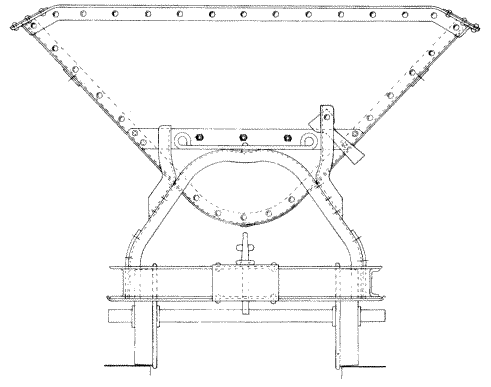
| THE INDUSTRIAL RAILWAY RECORD |
© FEBRUARY 1971 |
NARROW GAUGE WAGONS
|
W. G. ALLEN & SONS (TIPTON) LTD. |
C. G. DOWN |
It has long been a belief of mine that the railway enthusiast ‘profession’ tends to concentrate on the unusual to the exclusion of more conventional items. I was somewhat disconcerted therefore when it was pointed out to me that so far in this series I had been doing exactly that ! Accordingly, while I have no intention of disregarding the more novel types of wagon, I hope from time to time to cover some of the more commonplace types, the V-skips. At least, V-skips are commonplace only if lumped together under this heading; if the different types and makers are distinguished, then some designs become exceedingly rare.
The object of this article and some subsequent ones will be to describe some of the many types of V-skip that are to be found. I should mention at this point that I am always glad to receive details of any narrow gauge wagon, no matter how commonplace it might seem. The types of skip to be dealt with fall into my own arbitrary category and exclude the heavier types with sprung axles, complex brake gear, etc., which are more properly termed railway wagons and, as such, are quite distinct from the so-called ‘Jubilee’ skips whose essence is lightness and portability.
A brief mention of the usage of the word ‘skip’ might be of interest. In the south of England, the word implies the entire wagon but in other areas, Durham for example, usage is more precise, with only the body being termed the skip, while the frame and wheels constitute the 'tram’. There are no railway connotations at all in some cases, a skip being any form of receptacle, e.g. crane skips as used on building sites, or coal skips as in some collieries where skip winding is employed (although, in this latter usage, words such as kibble, bowk or hoppit are sometimes substituted). However, before becoming inextricably tangled in etymology, it would be best to continue with the article.
At their works at Tipton, Staffordshire, W. G. Allen & Sons (Tipton) Ltd produce a great variety of railway and other equipment and three of their skip designs fall within our scope.
(a) "Koppel" type
Otherwise known as the ‘Continental" type, this was the first of the three designs, the drawings being dated 30th March 1920. The drawing shows a 27cu ft capacity example of the type and demonstrates the basic feature of skips from this builder, namely that the body is longer at the top than the bottom. The body was built of 3mm plate, perhaps explaining the type designation, which was riveted to 1½in angle iron inside the body. The wrapping plate was of two separate sheets with a lap joint at the bottom. Straight rocker angles were bolted to the end sheets while a flat tipping strip ran along each side of the body. End standards and retaining horns were built from 2in x 1½ channel, suitably bent, while a simple pressed steel retaining catch, one at each end but on opposite sides, kept the body in place. A single length of channel, joined at one side, was used to form the frame.
(b) 1932 type
This design was produced between 1932 and 1939 from drawings dated 31st October 1932. In few respects was it similar to the 1920 design. The wrapping plate was formed from a single sheet of 1l8 in steel, thus eliminating the lap joint. Also, the angle forming the body rim was bent over at each end for ease of manual handling while the tipping strips were also of angle iron.

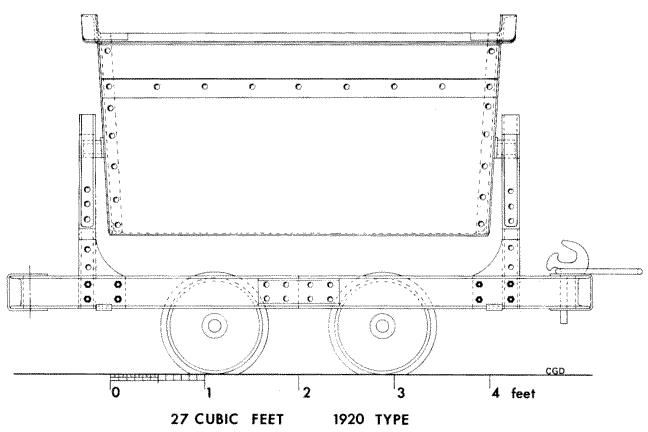
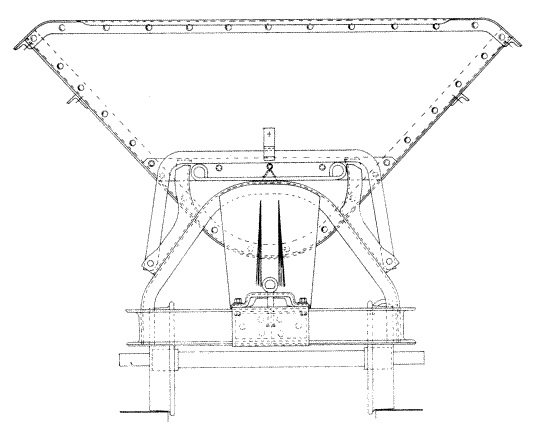
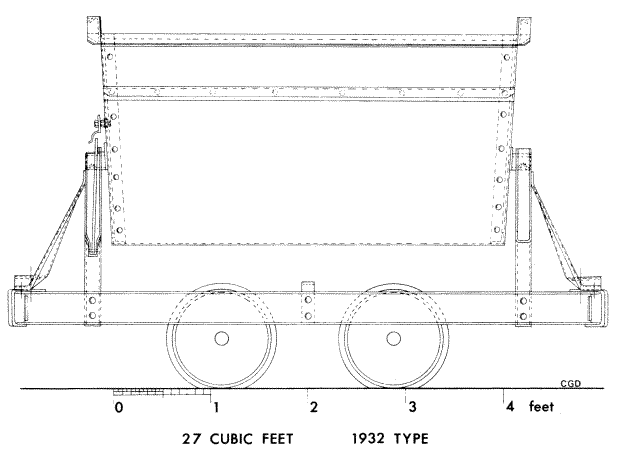

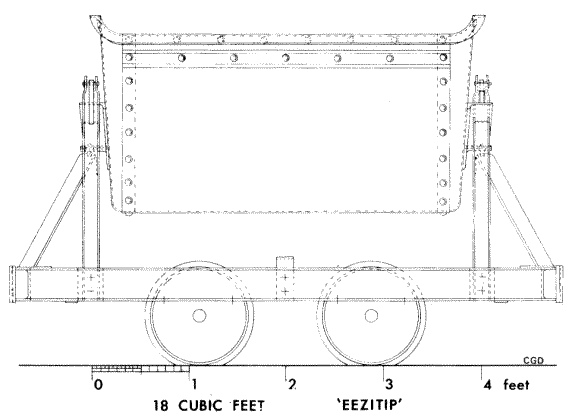
The main point of distinction though was the yoke-type retaining catch which took the form of a metal bar, at one end of the wagon only, which was loosely fixed to the horns. A small catch on the end sheet hooked over this bar and, to tip the body, it was only necessary to lift up this catch and pull the bar outwards. A different type of horn, made from pressed steel, was fitted. Pressed steel end stays were also included in the design, in order to strengthen the end standards, and these also formed the coupling pin socket. The frame, too, differs from the 1920 type in being formed of two pieces of channel joined behind the buffer plate.
(c) "Eezitip" type
From the description of the 1932 design, it will be apparent that it had several features that must have increased the cost of manufacture without any obvious advantages being gained. It is not therefore surprising that the design was rather short-lived and, in 1939, replaced by a new type that took full advantage of modern manufacturing methods and simplified construction considerably. Known as the "Eezitip" type, this is still in production, with small detail revisions. The example shown is a variation first produced in 1948, in which the rocker angle was positioned ¾in higher than in the 1939 type.
The "Eezitip" range has a standard set of body capacities of 13½, 18, 27 and 40cu ft, that shown in the drawing being a wagon of 18 cu ft capacity. Its design is quite obviously a great departure from earlier ones, replacing the straight rocker angle with a curved one and flat end standards to suit. While the body retains the feature of being longer at the top than the bottom, it differs in that the ends are formed from pressed steel plates, and the corners are therefore curved. A different tipping strip is fitted, being a channel beaded strip, while the retaining catch reverts to the 1920 simple pattern.
The frame is still in two sections but these are flashbutt-welded 3in from the transverse centre line of the frame and on opposite sides of it. Welding is a prominent feature of the design, the end standards being built up entirely by this means. In recent years, welding has been substituted for riveting in the construction of the body.
As regards the three examples described it should be noted that skips intended for locomotive haulage are normally fitted with a longitudinal stiffening bar down the centre line of the frame, in order to protect if from buffing shocks. In these three designs, the wheels are 1ft 0in diameter and the wheelbase 1ft 9in, although a 2ft 0in wheelbase was not unknown if specified by a customer.
To conclude, a few general points should be mentioned. When measuring skips it should be remembered that body dimensions, and sometimes frame dimensions as well, vary according to the capacity of the skip. Nor is it unknown for users to modify their standard skips either with parts of their own design or from other makers’ products. I know of at least one instance in which a wagon has been built up from the parts of three different makers.
Grateful thanks are extended to W.G. Allen & Sons (Tipton) Ltd for their help with information and drawings; and also to Mr S.A. Leleux.
|
|
|
|
Tenders invited for
: – "Supply of about 20 tons of light tramway rails, 20 lb. to the yard, delivered at either of the Oswestry stations. Particulars and price to Clerk of Works, Pen-y-Gwely Waterworks, Oswestry." ("Iron" 13th May 1892. – KPP)